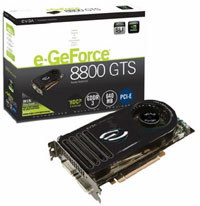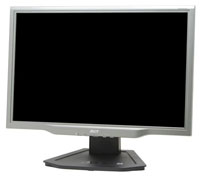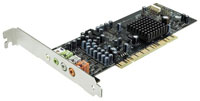Midrange Gaming Configuration
We've covered nearly all of the component choices necessary for a high-quality gaming solution already. The one major change that we would make would be to cut costs in most areas other than the graphics card, and then spend a large portion of the budget on getting a GPU that's as fast as possible. Here's what we came up with.
| Intel Mid-Range Gaming System |
| Hardware |
Component |
Price |
Rebates |
| Processor |
Intel Core 2 Duo E6300 (1.86GHz 2MB Shared) - Retail |
$185 |
|
| Motherboard |
Biostar TForce965PT (P965 775) |
$111 |
|
| Memory |
OCZ S.O.E 2x1GB DDR2-667 (OCZ2SOE6672GK) |
$221 |
$30 |
| Video Card |
eVGA GeForce 8800GTS 640MB (640-P2-N821-AR) |
$400 |
$20 |
| Hard Drive |
Seagate 320GB SATA 3.0Gbps 7200RPM 16MB (Barracuda 7200.10) |
$90 |
|
| Optical Drive |
LG Black 18X DVD+R (GSAH22N-BK) |
$36 |
|
| Case |
Cooler Master Centurion 534 (RC-534-KKN2-GP) |
$66 |
$10 |
| Power Supply |
Rosewill SLI 600W (RP600V2-S-SL) |
$73 |
|
| Display |
Acer AL2223Wd 22" 5ms (1680x1050) |
$314 |
|
| Sound Card |
Creative Sound Blaster X-Fi XtremeGamer 7.1 |
96 |
|
| Speakers |
Logitech X-530 5.1 70W Speakers |
$74 |
|
| Keyboard and Mouse |
Microsoft Comfort Curve 2000 B2L-00047 |
$28 |
|
| Operating System |
Windows XP MCE 2005 (with Vista coupon) |
$115 |
|
| Bottom Line |
|
$1809 |
$1749 |
 |
We pretty much took the base Intel midrange configuration and made several focused upgrades. The most significant change is going to be the inclusion of a GeForce 8800 GTS graphics card, and many people will be content to stop there. The GeForce 8800 GTS features DirectX 10 support (which of course will require Windows Vista and an updated public driver before it becomes useful) and it uses NVIDIA's new G80 core. We can't really evaluate DirectX 10 performance yet, but in currently shipping games the only single GPU solution that's faster than the 8800 GTS is the 8800 GTX. The GTS isn't a whole lot faster than AMD's X1950 XTX, and there are even a few games where it's slightly slower, but given the relatively similar prices and the improved feature set most gamers will prefer NVIDIA's offering right now.
 |
Besides the upgraded graphics card, we felt most gamers would appreciate moving to a larger LCD. We chose the Acer 22" LCD without HDCP support rather than the Sceptre we mentioned on the previous page, because many gamers really don't care too much about HDCP. We also added the larger 600W Rosewill power supply, and in order to get the most out of games we felt the inclusion of Creative's Sound Blaster X-Fi was warranted.
 |
Core 2 Duo generally does very well in gaming benchmarks, and anyone looking at doing even a moderate amount of overclocking will definitely get more mileage out of a Core 2 Duo chip. However, if you spend an equal amount of money on an AMD system, you can get an X2 4600+ that typically falls between the E6300 and E6400 in gaming performance (at stock speeds). Given the number of A-list games that currently benefit from multiple processor cores (all three of them!), you can even take things one step further and pick up a single core Athlon 64 3800+ to save even more money.
That said, we really hope 2007 will finally be the year where dual core processors begin to show more of a benefit in games. With such a high-end graphics card, the CPU could very well become a bottleneck, and several triple-A titles scheduled for the coming year look poised to put more of a strain on the CPU. While it might be interesting to contemplate using a single core processor with a high-end GPU in a gaming system, long-term that may prove to be a limiting solution and we don't recommend it.













43 Comments
View All Comments
JarredWalton - Sunday, January 21, 2007 - link
Some of the PCs are kept up to date for gaming parties and the like. Others are just mostly sitting around waiting for me to test something on an older platform or whatever. Others are basically spare parts. In the winter, I turn on a lot of them to provide heat - I only have electric heaters anyway, so whether I'm putting the electricity into the heaters or into PCs doesn't make much difference to me. I run Folding@Home in such cases to increase heat output, and if the house starts getting too warm I shut down systems. :)chrnochime - Friday, January 19, 2007 - link
Basic Config - AccessoriesBoth times that Fortron appeared, it was written as "Fotron". FSP would probably appreciate that you spell their name correctly....
JarredWalton - Friday, January 19, 2007 - link
Awesome! I've been misspelling their name for years and this is the first time anyone has corrected me. Oops! Thanks -- I will see to it that they don't make that mistake again. :-)JarredWalton - Friday, January 19, 2007 - link
Speech recognition. "they" = "I"noxipoo - Friday, January 19, 2007 - link
should be around $1500.screech - Friday, January 19, 2007 - link
basic midrange page:" With either of the above systems, you should easily be able to run all current applications, along with Windows Vista, with one possible exception: games. You can even run all current games,"
Perhaps a little rewording is in order? ;)
JarredWalton - Friday, January 19, 2007 - link
Not sure what you mean - maybe I'm just blind. Basically, you can run all current games, but not at maximum detail, hence it's a "possible exception".dqniel - Friday, January 19, 2007 - link
Rosewill PSUs? Absolutely awful. OCZ S.O.E. ram? Horrible track record with C2D chipsets and a poor price to performance ratio. G.Skill "HK" series RAM for the OCing system? 2x1GB kits using Micron D9 are available for the same price. A $267 Super Talent kit on Newegg for example. Asus P5B-E 1.02 motherboard? Not even available in the U.S. OCZ GameXStream PSU? Such horrible voltage ripple problems that I wouldn't trust it in a budget rig. The Corsair 520w or Zalman 600w would be much better choices.I'm confused as to how this thing got past quality control and was published.
JarredWalton - Friday, January 19, 2007 - link
Several editors felt the G.Skill RAM was a good choice, but the Super Talent is arguably just as good if not better. Considering the G.Skill is now out of stock, I'll switch the RAM to the Super Talent - which is not Micron D9 memory as far as I'm aware, but still uses Micron chips and performs quite well (unless you're looking at some other ST memory?). The OCZ S.O.E. mostly suffered from early P965 BIOS issues, and with the rebate it comes in as very good RAM for a relatively low price. If you don't like rebates, we would suggest other DDR2-800 RAM price at around $200, which will perform about the same (within 2% most likely). As for the rest...There are about five different 700W PSUs available that are all based off the 700W Fotron Source. OCZ GameXStream is the cheapest at present, and despite your concerns with the "horrible voltage ripple" we have found the PSU to work extremely well in various systems. The overall experience most people have had with this PSU is very good - no product is perfect, and there will always be a few bad units out there - and for the price it's difficult to say that any PSU is universally better. You can get quieter PSUs (with lower wattage ratings - although those are mostly hype), and the Corsair 520W you mention is a good PSU. Is it better, though? That's difficult to say.
The Rosewill PSU is in a different boat. Every time anyone recommends a PSU from some lesser brand, criticisms are sure to come. Rosewill PSUs in our experience are decent, and while Deer Electronics or Solytech or whoever may be the OEM, companies can and do get better. I've got one of the Rosewill 600W PSUs running a system and I've had no complaints with it. I haven't tried to overload the PSU to make it fail, but it appears to be about as good as several other ~550W PSUs I have (in terms of efficiency) and it's quite a bit cheaper. It's also a bit more noisy, but when you've got CrossFire X1900 GPUs most other fans are quiet by comparison. When it can run a CrossFire setup without any issues, that's pretty good for a $75 PSU. Of course, I'm not a PSU reviewer, but http://www.jonnyguru.com/review_details.php?id=48">JohnnyGuru took a look at a 500W Rosewill so maybe you'll trust his results? Not bad for a budget PSU, and it's probably safe to say the 600W listed in this BG is of similar quality to their 500W unit.
Finally, for the motherboard I've listed the DS3 and the P5B-E, on the recommendation of Gary as he tends to do most of our motherboard reviews and he's tried all of the boards. My understanding was that the 1.02G is available in the US, but perhaps you're right. The P5B-E still offers a few features other boards lack at that price point, so depending on whether you prefer better OC'ing (DS3) or features will determine which board is right for you.
If singling out 5 components out of 31 that you dislike turns an article into a horrible mess that's not worthy of publication, I'm sorry to disappoint. I can't say for certain that every one of these components is best in class and will work with every possible system configuration out there (i.e. motherboards can be picky about RAM at times), but I can say that the configurations listed will work very well according to our testing of the various parts. Most of the criticisms you've brought up will hardly make a difference on the final result.
dqniel - Friday, January 19, 2007 - link
Let me first state that perhaps I exaggerated a bit. I didn't mean to imply that the guide was "a horrible mess." Simply put, I think the guide is below Anandtech's standards in terms of having nearly perfect product selection in the given price range. Why settle for "...will hardly make a difference on the final result" when you can squeeze out that extra little bit of performance and stability for your money?I'm sticking by my Super Talent remark in that it has D9GMH chips: http://www.newegg.com/Product/Product.asp?Item=N82...">http://www.newegg.com/Product/Product.asp?Item=N82... (this particular model)
Secondly, I'm glad that you could inform me that most of the S.O.E. problems have been fixed by BIOS updates. I'm sure either the S.O.E. or similarly priced Adata would be perfect choices for the rigs.
As far as the PSUs are concerned- as I'm sure you know, most PSU companies will use varying OEM manufacturers from model to model. The particular Rosewill PSU you chosen, because of the poor choice of OEM manufacturer, for the 600w unit is well below the standards of other budget PSUs such as the Enhance GH models available at the reputable www.ewiz.com. Secondly, there is no reason to get a 700w PSU for the system you suggested even with heavy overclocking thrown into the mix. Power consumption is blown out of proportion and quality is greater than quantity since most companies' units don't actually meet their specified outputs. Because of this, a $120 Corsair HX or $120 Zalman 600w would be a better choice. Adequate power with better quality in terms of ripple while costing less seems like a logical choice. Sure, ripple won't cause any performance problems in the short term, but Jonnyguru and others have stated that in the long run it leads to the death of sensitive components such as RAM. The FSP Epsilon-based units are some of the worst available (with the exception of the Zalman unit) in terms of putting out dangerous ripple.
The P5B-E 1.02 was renamed after the article you guys published. It was released overseas as the P5B-E Plus and is impossible to find in the states without paying ludicrous amounts. The Gigabyte DS3 and P5B-E Deluxe are both fantastic and widely available, however.